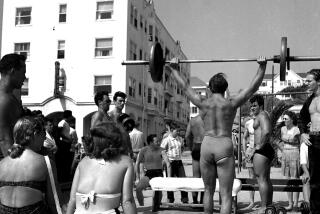Just Do It
- Share via
Don’t tell Porter Shimer you don’t have time to exercise.
The author of “Too Busy to Exercise” (Storey Communications, 1996) is apt to rattle off a guilt-inducing nine or 10 ways to work out at home, at work, on the road or even without leaving your desk, your car or the front of your television.
“If you’re too busy to exercise,” Shimer said, “you’re too busy to breathe.”
A 48-year-old, self-confessed “slave to my own need to work out,” Shimer said he developed the book partly from fitness strategies he’s used over the last 20 years.
Although a back injury has sidelined him from many of his former activities--including wrestling, marathon running, football, tennis and baseball--”I don’t think I’ve missed a workout in years,” he said.
“Even when I travel, I’m a genius for coming up with things you can do in a hotel room or airports.”
Shimer also was spurred by new research. Government guidelines now say that 30 minutes a day of any kind of physical activity is enough to keep most people fit, he said.
“It’s not that we’re too busy to exercise,” Shimer explained. “The problem is that we’ve been brainwashed in the way that exercise has been traditionally been approached.
“There’s this mind-set that you need this special exercise wardrobe and a shower and big blocks of time, and that’s what puts people off.”
Shimer said the exercise guidelines issued in 1995 began with a study published in the Journal of the American Medical Assn. in November 1987.
The study found that men who were getting exercise through everyday activities, such as walking and gardening, had hearts as healthy as those who were exercising in more traditional ways, such as jogging or stair-stepping machines.
More recently, studies suggest that burning only 1,000 to 2,000 additional calories a week in physical activity about 30 minutes a day is enough to accrue substantial cardiovascular improvement and protection from heart disease.
But the best news, Shimer said, is that those 30 minutes don’t have to come all at once. As evidence, he pointed to a study of overweight women in a walking program. The study was published in the 1995 edition of the International Journal of Obesity.
The research found that when the women could divide 40 minutes of walking into three segments of whatever length they wanted, the women lost an average of five pounds more over 20 weeks than the single-workout group.
Shimer said experts believe a daily exercise regimen should include three types of activity: a cardiovascular or aerobic component for improving heart and lung function and for burning calories; a strength-building component to increase muscle mass; and a flexibility component for relief of stiffness and stress.
The requirements can easily be fulfilled, he said. In the morning, for example, all it takes is a five- to 10-minute stretching routine before you get out of bed or while you’re in the shower, five to 10 minutes of strength exercises and a 10- to 20-minute brisk walk with (or without) a dog.
The book provides a section with 50 illustrated exercises for both strength and flexibility, and dozens of cardiovascular ideas.
A great believer in the value of isometric exercises, in which the body’s own muscles and / or an object are used to provide resistance, Shimer suggests them as a way of getting in a workout while at a sedentary job.
He also suggests stretches that can be done at a desk, 19 ideas for decaffeinated and de-calorized coffee breaks and walking the corporate corridors or campus at lunch and using the company fitness facility if one is available.
Have children? Get yourself involved in their sports activities, Shimer said. “Sporting activities take the drudgery out of exercise. If you get involved in a softball game with your kids, you forget you’re exercising.”
Unfortunately, the news on the exercise front is not all cheery. Results of the National Runners Health Study published recently in the American Journal of Clinical Nutrition tend to negate the government activity guidelines.
In the study of more than 4,000 male runners between 18 and 49, researchers found that, regardless of their mileage level, the men still gained weight around their middle as they aged unless they increased the number of miles they ran.
Study author Dr. Paul T. Williams said that means that guidelines that simply urge “keeping active” as you grow older don’t go far enough.
To avoid gaining weight, and weight-related health problems, “You have to become more active as you get older,” he said. “It’s going to mean pushing people further as they grow older.”


